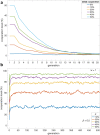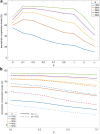Cooperation without punishment
- PMID: 36681708
- PMCID: PMC9867775
- DOI: 10.1038/s41598-023-28372-y
Cooperation without punishment
Abstract
A fundamental question in social and biological sciences is whether self-governance is possible when individual and collective interests are in conflict. Free riding poses a major challenge to self-governance, and a prominent solution to this challenge has been altruistic punishment. However, this solution is ineffective when counter-punishments are possible and when social interactions are noisy. We set out to address these shortcomings, motivated by the fact that most people behave like conditional cooperators-individuals willing to cooperate if a critical number of others do so. In our evolutionary model, the population contains heterogeneous conditional cooperators whose decisions depend on past cooperation levels. The population plays a repeated public goods game in a moderately noisy environment where individuals can occasionally commit mistakes in their cooperative decisions and in their imitation of the role models' strategies. We show that, under moderate levels of noise, injecting a few altruists into the population triggers positive reciprocity among conditional cooperators, thereby providing a novel mechanism to establish stable cooperation. More broadly, our findings indicate that self-governance is possible while avoiding the detrimental effects of punishment, and suggest that society should focus on creating a critical amount of trust to harness the conditional nature of its members.
© 2023. The Author(s).
Conflict of interest statement
The authors declare no competing interests.
Figures



Similar articles
-
Decoupling cooperation and punishment in humans shows that punishment is not an altruistic trait.Proc Biol Sci. 2021 Nov 10;288(1962):20211611. doi: 10.1098/rspb.2021.1611. Epub 2021 Nov 10. Proc Biol Sci. 2021. PMID: 34753350 Free PMC article.
-
When is altruistic punishment useful in social dilemmas?Biosystems. 2018 Dec;174:60-62. doi: 10.1016/j.biosystems.2018.10.015. Epub 2018 Nov 2. Biosystems. 2018. PMID: 30391264
-
Symbiotic behaviour in the public goods game with altruistic punishment.J Theor Biol. 2021 Sep 7;524:110737. doi: 10.1016/j.jtbi.2021.110737. Epub 2021 Apr 28. J Theor Biol. 2021. PMID: 33930439
-
Punishment and spite, the dark side of cooperation.Philos Trans R Soc Lond B Biol Sci. 2010 Sep 12;365(1553):2635-50. doi: 10.1098/rstb.2010.0146. Philos Trans R Soc Lond B Biol Sci. 2010. PMID: 20679108 Free PMC article. Review.
-
Cheating and punishment in cooperative animal societies.Philos Trans R Soc Lond B Biol Sci. 2016 Feb 5;371(1687):20150090. doi: 10.1098/rstb.2015.0090. Philos Trans R Soc Lond B Biol Sci. 2016. PMID: 26729930 Free PMC article. Review.
Cited by
-
Maintaining cooperation through vertical communication of trust when removing sanctions.Proc Natl Acad Sci U S A. 2025 Mar 25;122(12):e2415010122. doi: 10.1073/pnas.2415010122. Epub 2025 Mar 17. Proc Natl Acad Sci U S A. 2025. PMID: 40096613
-
Co-evolution of conditional cooperation and social norm.Sci Rep. 2023 Oct 3;13(1):16625. doi: 10.1038/s41598-023-43918-w. Sci Rep. 2023. PMID: 37789098 Free PMC article.
References
-
- Nikiforakis N. Punishment and counter-punishment in public good games: Can we really govern ourselves? J. Public Econ. 2008;92:91–112. doi: 10.1016/j.jpubeco.2007.04.008. - DOI
-
- Olson, M. The logic of collective action [1965]. Contemporary Sociological Theory124 (2012).
-
- Ostrom E. Collective action and the evolution of social norms. J. Econ. Perspect. 2000;14:137–158. doi: 10.1257/jep.14.3.137. - DOI
MeSH terms
LinkOut - more resources
Full Text Sources
Miscellaneous

